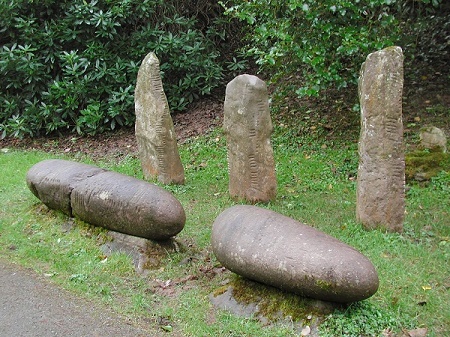Type: Ogham
Townland: Baile an Ghóilín Townland of the little creeks

The original site of this stone is unknown. It was first noted in its current location at Burnham House/Coláiste Íde (Macalister 1945, 167-8), in the townland of Burnham West and barony of Corkaguiney.
MonumentThe original provenance of this stone is not recorded (see KE000-002----). It formed part of Lord Ventry's collection and now lies on the verge of the driveway leading to Coláiste Íde.
It measures 1.06m long x c. 1.14m in circumference.
The inscription runs up-top-down. 'The scores are of small size, those of the vowels and the consonants being of about the same length, and distinguished by position only... The engraver had to reduce his exuberant double consonants toward the end of the inscription for want of space' (Macalister 1945, 167-8). Macalister (1945, 167-8, no. 175) read the inscription as: MAQQI-ERCCIA MAQQI MUCOI DOVINIA and noted that this stone resembles the Ballintaggart group. Many of the scores are extremely faint and only the last word can now be traced in full. (Cuppage 1986, no. 799)
Translation'Of Mac-Erce son of the descendant of Duibne'.
CommentaryThe loss of final -S in DOVINIA and probably MAQQI-ERCCIA suggests dating this inscription to the first half of the sixth century (McManus 1991, 95, 97). MAQ(Q)I- (gen. of MAQQAS), as a first element meaning 'devotee' or the like, rather than 'son', and Erc? (a divine name) 'heaven' or 'cow'? (McManus 1991, 107, 108-9). Cp. CIIC 125. Rooves More II, Cork (MAQI-ERCIAS MAQI VALAMNI); CIIC 169. Ballyeightragh, Kerry (MAQI-LIAG MAQI-ERCA); CIIC 178 Coomeenole, Kerry (ERC MAQI MAQI-ERCIAS MU DOVINIA); CIIC 205. Derrygariff, Kerry (S ... BNAG M[AQQ]I-RC̣IA ); CIIC 262. Seemochuda, Waterford (ERCAGNI MAQ[I-ERCIAS]). All but one of the inscriptions containing the tribal name DOVINIAS ('of Duibne') have been found on the Dingle peninsula, barony of Corkaguiney (Corcu Duibne), which got its name from that tribe or sept (McManus 1991, 111).
History of RecordingAt Burnham House (now Coláiste Íde), between Dingle and Ventry. The present location of this stone may be accessed via the National Monuments Service Historic Environment viewer on www.archaeology.ie. (GPS coordinates-10.306267, 52.126711)
Site recorded by:Kathleen Reen